Refinement of saliva microRNA biomarkers for sports-related concussion
Stvn D.Hcs *,Cyc Ons ,Ryon Y.K ,Kvn J.Zn ,Jyson Lort ,Anr C.Lort ,Rort P.Oyp,Grory Forc,Snt DVt,Zo Gnon,Cn McLoun,Mu M.Mr,Scott L.Zucrn,Toty L,Mttw Hr,Cuc Montt,Tos R.Cp,Crstopr Nv,Es Fnr,Mc N.Drtsc
a Department of Pediatrics,College of Medicine,Pennsylvania State University,Hershey,PA 17033,USA
b Department of Orthopaedics and Rehabilitation,College of Medicine,Pennsylvania State University,Hershey,PA 17033,USA
c Department of Family Medicine,College of Medicine,Pennsylvania State University,Hershey,PA 17033,USA
d Department of Emergency Medicine,College of Medicine,Pennsylvania State University,Hershey,PA 17033,USA
e Department of Research and Development,Quadrant Biosciences Inc.,Syracuse,NY 13210,USA
f Department of Biology,Marist College,Poughkeepsie,NY 12601,USA
g Sports Concussion Center,College of Medicine,Vanderbilt University,Nashville,TN 37212,USA
h Department of Family Medicine,College of Osteopathic Medicine,New York Institute of Technology,Old Westbury,NY 11568,USA
i Department of Athletic Training,Colgate University,Hamilton,NY 13346,USA
j Department of Rehabilitation Sciences,Old Dominion University,Norfolk,VA 23529,USA
k Department of Physical Therapy Education,Orthopedics,and Neuroscience,College of Medicine,SUNY Upstate Medical University,Syracuse,NY 13210,USA
l Department of Exercise Science,Syracuse University,Syracuse,NY 13210,USA
m Department of Medical Research—West,Walter Reed Army Institute of Research,US Army Joint Base Lewis-McChord,Hillhurst,WA 98433,USA
Abstract Background: Recognizing sport-related concussion (SRC) is challenging and relies heavily on subjective symptom reports.An objective,biological marker could improve recognition and understanding of SRC.There is emerging evidence that salivary micro-ribonucleic acids(miRNAs)may serve as biomarkers of concussion;however,it remains unclear whether concussion-related miRNAs are impacted by exercise.We sought to determine whether 40 miRNAs previously implicated in concussion pathophysiology were affected by participation in a variety of contact and non-contact sports.Our goal was to refine a miRNA-based tool capable of identifying athletes with SRC without the confounding effects of exercise.Methods: This case-control study harmonized data from concussed and non-concussed athletes recruited across 10 sites.Levels of salivary miRNAs within 455 samples from 314 individuals were measured with RNA sequencing.Within-subjects testing was used to identify and exclude miRNAs that changed with either(a)a single episode of exercise(166 samples from 83 individuals)or(b)season-long participation in contact sports(212 samples from 106 individuals).The miRNAs that were not impacted by exercise were interrogated for SRC diagnostic utility using logistic regression(172 samples from 75 concussed and 97 non-concussed individuals).Results: Two miRNAs(miR-532-5p and miR-182-5p)decreased(adjusted p <0.05)after a single episode of exercise,and 1 miRNA(miR-4510)increased only after contact sports participation.Twenty-three miRNAs changed at the end of a contact sports season.Two of these miRNAs(miR-26b-3p and miR-29c-3p) were associated (R >0.50;adjusted p <0.05) with the number of head impacts sustained in a single football practice.Among the 15 miRNAs not confounded by exercise or season-long contact sports participation,11 demonstrated a significant difference(adjusted p <0.05)between concussed and non-concussed participants,and 6 displayed moderate ability(area under curve >0.70)to identify concussion.A single ratio(miR-27a-5p/miR-30a-3p)displayed the highest accuracy(AUC=0.810,sensitivity=82.4%,specificity=73.3%)for differentiating concussed and non-concussed participants.Accuracy did not differ between participants with SRC and non-SRC (z=0.5,p=0.60).Conclusion: Salivary miRNA levels may accurately identify SRC when not confounded by exercise.Refinement of this approach in a large cohort of athletes could eventually lead to a non-invasive,sideline adjunct for SRC assessment.
Keywords: Biomarker;Contact sports;Football;RNA;Traumatic brain injury
1.Introduction
Sport-related head trauma is one of the most common causes of concussion.1Field-side assessment of sport-related concussion (SRC) relies on subjective symptom reports.However,some athletes may conceal symptoms to keep playing.2Neurocognitive and balance assessments may also be administered,but these can be manipulated to expedite return to play.3,4As a result,there has been much interest in developing a biological test (i.e.,biomarker) for concussion.5Biomarkers have been defined by the World Health Organization as“a substance,structure,or process that can be measured in the body or its products and influence or predict the incidence of outcome or disease”.6A biomarker would add objectivity to the diagnosis and management of SRC,thereby reducing external pressures on athletes to report symptoms.Such a test might also be used to stratify biological phenotypes within SRC,leading to individualized prognoses and treatment protocols.7
There is growing evidence that levels of micro-ribonucleic acids (miRNAs) are altered in the cerebrospinal fluid,8blood,9,10and saliva11,12of individuals with concussion.Salivary miRNAs,in particular,possess several qualities of an ideal SRC biomarker: (1) released from cranial nerves in the oropharynx within minutes of head impact,13these molecular“switches” provide a rapid window into the physiology of the injured brain;(2) certain miRNAs are highly enriched within neurons,yielding a brain-specific signature;14,15and (3)neurons can package miRNAs within protective vesicles,16which renders them stable,and easily measured through a noninvasive collection process.12Recently,we demonstrated that salivary miRNA levels could identify individuals with concussion with similar accuracy to traditional balance and neuropsychological measures,and pairing salivary miRNA measures with subjective symptom reports could enhance diagnostic accuracy.17Successful application of saliva miRNA technology will require researchers to determine how individual characteristics(such as previous concussion history)to impact miRNA levels,while thoroughly investigating test-retest reliability and change indices.18,19Application as a sideline tool for SRC will also require an understanding of how acute and chronic exercise impacts saliva miRNA levels.
Individual miRNAs that reflect the physiological changes occurring with exertion,cumulative fatigue,minor musculoskeletal injuries,or enhanced conditioning may be unsuitable for SRC detection.20Several studies have examined the impact of contact and non-contact sports participation on blood miRNA levels.21-23Several studies seeking to develop saliva miRNA biomarkers for concussion have utilized athletes from specific contact sports as controls.13,17,24However,few studies have specifically examined the acute response of saliva miRNAs to exercise.25,26To our knowledge,no study has described saliva miRNA dynamics across a wide range of contact and non-contact sports or determined the effects of season-long contact sport participation on saliva miRNA levels.Such knowledge is critical for development of accurate miRNA biomarkers of SRC because saliva miRNAs that change during season-long sport participation may confound comparisons with pre-season baseline levels.Likewise,saliva miRNAs that change during acute exercise may confound field-side SRC tests.The purpose of this study was to identify and exclude saliva miRNAs confounded by exercise,in order to refine a saliva miRNA approach for sideline detection of SRC.
We hypothesized that a subset of 40 miRNAs previously shown to identify concussion17,27would be impacted by a single episode of exercise or display longitudinal accumulation across an entire season of contact sport participation,rendering them unsuitable as concussion biomarkers.We posited that the remaining miRNAs (i.e.,those unaffected by exercise) could accurately differentiate athletes with SRC from peers with recent participation in contact and non-contact sports.To our knowledge,this is the first study to harmonize salivary miRNA profiles from a large cohort of athletes participating in both contact and non-contact sports during periods of acute and chronic exercise.
2.Methods
2.1. Ethics statement
Ethical approval for this study was provided by Western Institutional Review Board Study (#1271583).Institutional approval was also provided by collaborating institutions: Pennsylvania State University (STUDY00003729),SUNY Upstate Medical University(1070727),Marist College(#S18-033),Syracuse University (#17-374),Vanderbilt University (#181814),Bridgewater College (19-005),and the United States Army,Regional Health Command-Atlantic (#1510001-1).Written informed consent/assent was obtained from all participants.
2.2. Experimental design
The goal of this prospective multi-center study was to refine a set of 40 saliva miRNAs with diagnostic potential for SRC17,27by eliminating miRNAs confounded by acute or chronic exercise,which would negatively impact the accuracy of field-side miRNA measurement or post-injury comparisons to a pre-season miRNA baseline.To achieve this goal,the study employed a 3-step approach: (1) saliva miRNAs impacted by “acute exercise” were identified within 83 individuals who completed a single workout involving one of 4 sports (running,rowing,soccer,or football);(2) saliva miRNAs impacted by “chronic exercise” were identified within 106 individuals who completed a full season involving one of 5 full-contact sports (lacrosse,basketball,hockey,soccer,or mixed martial arts);and (3) the ability of saliva miRNAs not impacted by “acute exercise” or “chronic exercise” to differentiate 75 individuals with recent concussion(≤24 h post-injury)from 97 individuals without recent concussion was assessed via logistic regression analysis.Misclassification rates were compared between individuals with SRC and individuals with non-SRC as well as between individuals with recent exercise and without recent exercise.
2.3. Participants
The study included a convenience sample of 455 saliva samples from 314 individuals,aged 8-58 years.All participants were enrolled as part of a larger parent study17at 10 institutions: Bridgewater College (n=20),Colgate University(n=106),the United States Army Combative School(n=27),Marist College (n=45),Penn State University (n=52),New York Institute of Technology(n=28),SUNY Upstate Medical University (n=17),Syracuse University (n=12),Temple University (n=6),and Vanderbilt University (n=1).Recruitment was performed by research staff at affiliated emergency departments,athletic training facilities,and acute care clinics.Inclusion criteria were(1)concussion within the previous 24 h(identified by licensed clinicians using the 2016 Concussion in Sport Group definition28) or (2) active participation in organized sport (defined as participation in a collegiate,semiprofessional,or military-affiliated athletic event).Exclusion criteria for all participants were primary language other than English,pregnancy,periodontal disease,neurologic disorder(e.g.,epilepsy),drug/alcohol dependency,respiratory infection,and orthopedic injury (sprain,contusion,or fracture within 14 days of enrollment).Participants with concussion were excluded for Glasgow Coma Score of ≤13 at the time of initial injury,penetrating head injury,symptoms attributable to underlying psychological disorder(e.g.,depression,anxiety,post-traumatic stress disorder),over-night hospitalization for concussion,skull fracture,or findings of intracranial bleed on imaging(if performed).
2.3.1.Group 1:Acute exercise
First,we sought to determine the acute impact of exercise on concussion-related miRNAs and assess whether exerciseinduced changes in saliva miRNAs differed between athletes in contact versus non-contact sports.We assessed miRNA levels within 166 saliva samples from 83 individuals.Paired saliva samples were collected from each individual between 15 min and 60 min prior to sport participation,and again within 20 min of exercise completion.There were 51 participants in non-contact sports: 25 collegiate distance runners completing their weekly “long run” (duration of ≥55 min,covering ≥20% of weekly running distance29);20 college students completing a graded treadmill protocol;and 6 collegiate rowers completing a high-intensity 50-min ergometer workout.There were 32 participants in contact sports: 12 semi-professional soccer players participating in a 45-min,full-contact scrimmage;and 20 collegiate football athletes completing a full-contact practice that was 120 min in duration.The number of head impacts sustained by each contact sport athlete were recorded through direct observation by research staff (4 researchers observed 4 different athletes across 5 separate practices).None of the participating athletes were diagnosed with a concussion during the practice.
2.3.2.Group 2:Chronic exercise(season-long contact sport participation)
Second,we sought to determine whether concussion-related saliva miRNAs change as a result of chronic exercise(throughout a season of contact sport participation).We assessed miRNA levels within 212 paired saliva samples from 106 athletes.Saliva was collected at the outset of the athletic season from 83 athletes involved in lacrosse,basketball,hockey,or soccer,as well as 23 U.S.Army soldiers performing mixed-martial arts training.Saliva samples were collected from each individual again at the completion of the athletic season (30-115 days after enrollment).None of the participants were diagnosed with a concussion during the course of their athletic season.
2.3.3.Group 3:SRC diagnosis
Third,we sought to employ salivary miRNAs unaffected by exertion or season-long participation in contact sports (in Groups 1 and 2) to refine a diagnostic adjunct for SRC.We assessed salivary miRNA levels within 172 saliva samples from 172 athletes.There were 75 individuals with concussion and 97 without concussion.The participants without concussion included 46 college athletes who had participated in sport≤30 min prior to saliva collection,and 51 college athletes with no recent sport participation immediately prior to saliva collection.Concussion mechanism was self-reported as sportrelated (n=42) or non-sport-related (n=33).Athletes with non-SRCs were included in order to determine whether a predictive model using saliva miRNAs would perform similarly for SRCs and non-SRCs.
2.4. Measures
Medical and demographic information (sex,age,race,anthropometrics,dietary restrictions,and co-morbid medical conditions) was collected from all participants via survey.Presence/absence of any previous concussion was selfreported.For athletes with acute participation in contact sports,the number of head impacts sustained during practice was recorded through 1:1 observation by research staff.Helmet-to-ground,helmet-to-helmet,and helmet-to-body impacts were counted.Saliva was collected from each participant following oral tap-water rinse,in a non-fasting state,using swabs (OraCollect RE-100;DNA Genotek,Ottawa,Canada) or expectorant kits (OraCollect P-157;DNA Genotek).Per manufacturer instructions,samples were stored at room temperature for up to 60 days prior to their shipment to the SUNY Genomic Core Facility.Samples were then incubated at 50°C and frozen at-20°C prior to RNA analysis.
2.5. Saliva RNA analysis
As we have previously reported,17,29RNA was isolated from each saliva sample per manufacturer instructions with the miRNeasy Kit ( 217084;Qiagen Inc.,Germantown,MD,USA).RNA quality was assessed using the Agilent 2100 Bioanalyzer (Agilent Technologies,Inc.,Santa Clara,CA,USA).The TruSeq Small RNA Library Prep Kit(RS-122-2001;Illumina,San Diego,CA,USA) was used to prepare RNA libraries.Sequencing was performed on an Illumina NextSeq(Nextseq500;Illumina) instrument at a sequencing depth of 10 million reads/sample.Cutadapt (https://cutadapt.readthe docs.io/en/stable/) was used to remove adapter sequences,30prior to alignment with miRBase22 using Bowtie (http://bowtie-bio.sourceforge.net/index.shtml).Quantification was performed via SamTools (http://www.htslib.org/) using a custom-built bio-informatics architecture.31Aligned reads were quantile normalized.Each miRNA feature was scaled(mean-centered,divided by the feature standard deviation).Down-stream analysis focused on 40 miRNA candidates previously identified in published studies of traumatic brain injury.17,27
2.6. Statistical analysis
The acute influence of exercise on salivary levels of concussion-related miRNAs was assessed (166 samples,83 participants)using a within-subject non-parametric two-way analysis of variance.Levels of the 40 miRNAs were the dependent factors.Exercise status(pre-/post-participation)and sport type(contact/non-contact) were the independent variables.The cumulative effect of season-long contact sport participation on miRNA levels was assessed (212 samples,106 participants)using a within-subject non-parametric one-way analysis of variance.To explore whether the miRNAs displaying seasonlong changes during contact sport participation might be affected by cumulative head impacts (as opposed to cumulative fatigue,minor musculoskeletal injuries,or enhanced conditioning),we performed Spearman’s rank testing to identify associations between pre-/post-practice changes in miRNA levels and the number of head impacts sustained during practice.Finally,the salivary miRNAs that demonstrated no effect of acute exercise or season-long sports participation in the previous analyses were interrogated for the ability to differentiate 75 concussed and 97 non-concussed participants via logistic regression analysis.Accuracy of each miRNA was assessed by 100-fold cross-validated area under the receiver operating characteristic curve(AUC).Sensitivity,specificity,positive/negative likelihood ratios,and between groups differences (on non-parametric Wilcoxon rank testing)were also determined for each miRNA.To promote translation to a sideline point-of-care device using dual-channel polymerase chain reaction (which allows quantification of 2 miRNAs in 1 well),the miRNA ratio with the highest AUC was used to develop a logistic regression model that predicted concussion status within the Metaboanalyst v4.0 biomarker toolkit.32To assess the potential confounding effects of exercise on the predictive model,a two-proportionztest was used to compare misclassification rates of concussed individuals with SRCvs.non-SRC.Statistical analyses were performed in Metabolanalyst,32and Benjamini-Hochberg correction was applied to all analysis of variance results.Ana prioripower analysis using MDAnderson Bioinformatics software (https://bioinformatics.mdanderson.org/MicroarraySampleSize) determined that a sample size of 14 participants per group provided 80% power to detect a 1.5-fold difference among 40 miRNAs(per-gene α=0.05),based on the standard variance observed in our previous miRNA datasets.12,13,25
3.Results
3.1. Participant characteristics
Participants were mostly college-aged,Caucasian males(Table 1).Few participants had anxiety (8/314;3%),depression(14/314;5%),attention deficit hyperactivity disorder(11/314;4%),or dietary restrictions (25/314;8%).One-quarter of the participants(78/314;25%)had suffered a previous concussion.

Table 1 Participant characteristics.
3.2. Salivary miRNAs within a single episode of acute exercise
Assessment of the 40 concussion-related miRNAs among 83 individuals immediately before/after participation in contact (n=32) or non-contact sports (n=51) revealed 2/40 miRNAs with an effect (adjustedp< 0.05) of exercise(Fig.1A).Levels of both miR-532-5p and miR-182-5p decreased with exercise.Only 1 miRNA responded uniquely to contact sports (i.e.,displayed an interaction effect between exercise and sport-type).Levels of miR-4510 increased only among contact sport athletes(Fig.1B).There was no relationship between the number of observed head impacts and levels of miR-532-5p (r=0.16,p=0.48),miR-182-5p (r=0.15,p=0.50),or miR-4510 (r=0.17,p=0.46) among athletes involved in contact sports.
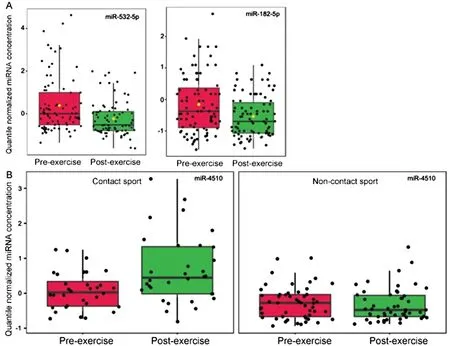
Fig.1.Three salivary miRNAs acutely impacted by sport participation.(A) The box plots represent quantile normalized concentrations for 2 miRNAs (miR-532-5p and miR-182-5p)with a significant change(adjusted p <0.05)among 83 athletes from pre-exercise(red)to post-exercise(green);(B)There was 1 miRNA(miR-4510)with a significant interaction (adjusted p <0.05) between sport type and exercise.Levels of miR-4510 increased among 32 contact sport athletes post-exercise,but not among 51 non-contact sport athletes.miRNA=micro ribonucleic acid.TagedEnd
3.3. Salivary miRNAs across a season of contact sport participation
Comparison of saliva miRNA levels within 106 collegiate athletes and soldiers participating in contact sports demonstrated changes (adjustedp<0.05) in 23/40 concussionrelated miRNAs at the end of the season(Fig.2).There were 9 miRNAs that increased and 14 miRNAs that decreased at the end of the season.One of these miRNAs (miR-532-5p) had also displayed decreased levels with acute exercise.Among 20 football athletes participating in a full-contact practice,pre/post-practice changes in 2 of the 23 miRNAs demonstrated an association (R>0.50,p<0.05) with the number of head impacts sustained during practice(Fig.3).Levels of miR-29c-3p increased with the number of head impacts (R=0.59,p=0.006),while levels of miR-26b-3p decreased with the number of head impacts (R=-0.51,p=0.020).Similarly,levels of miR-29c-3p also increased during contact sportsseason,whereas miR-26b-3p levels decreased,suggesting these season-long changes might be related to cumulative head impacts.
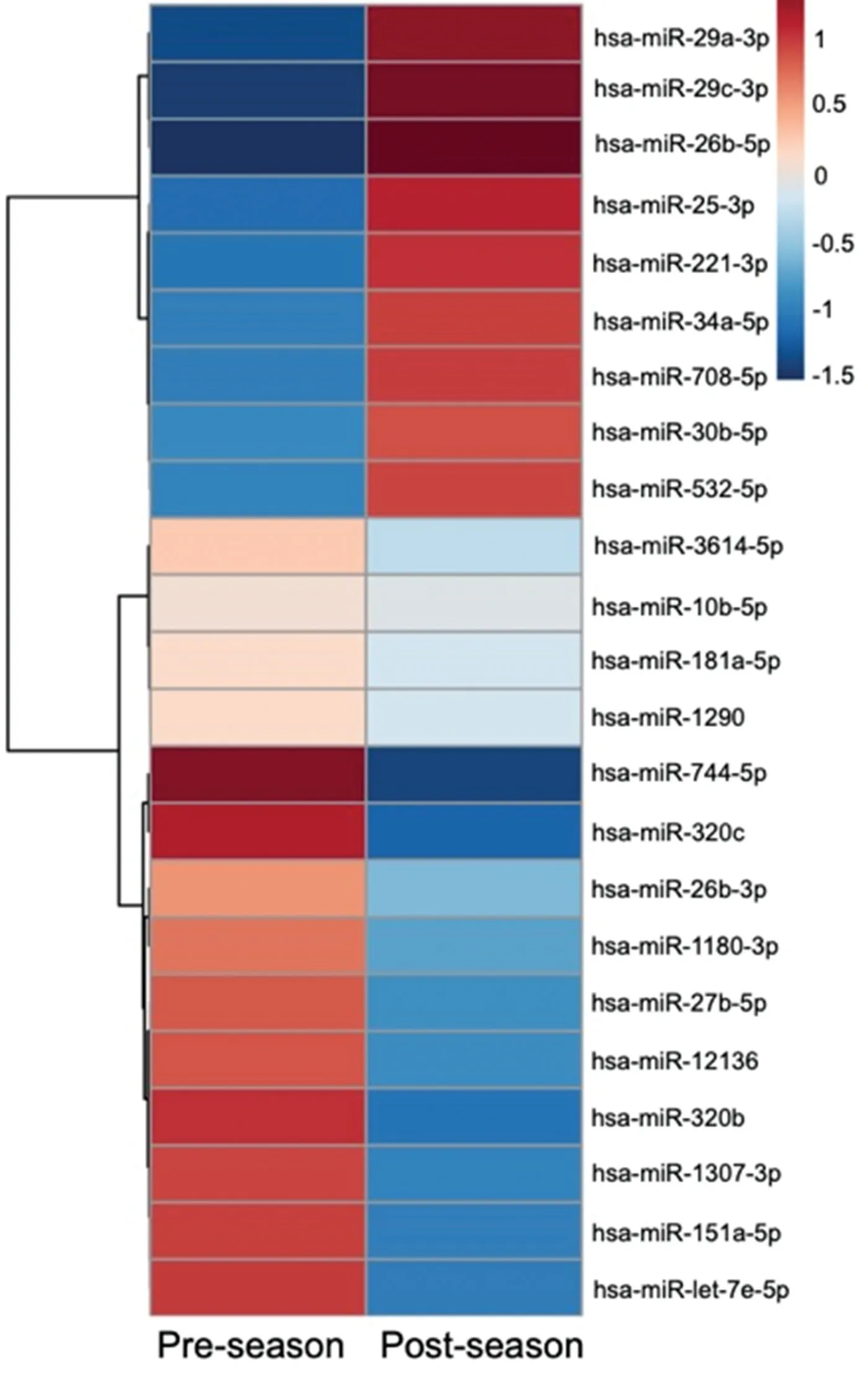
Fig.2.Twenty-three salivary miRNAs change at the end of a contact sports season.The heat map displays mean levels of 23 miRNAs that showed a significant change (adjusted p <0.05) between pre-and post-season levels among 106 athletes and soldiers participating in contact sports.There were 14 miRNAs with decreased salivary levels (blue) at the end of the season,and 9 miRNAs with increased salivary levels(red).The miRNAs are clustered based on expression similarity using a Ward clustering algorithm with a Pearson distance metric.hsa=Homo sapiens;miRNA=micro ribonucleic acid.
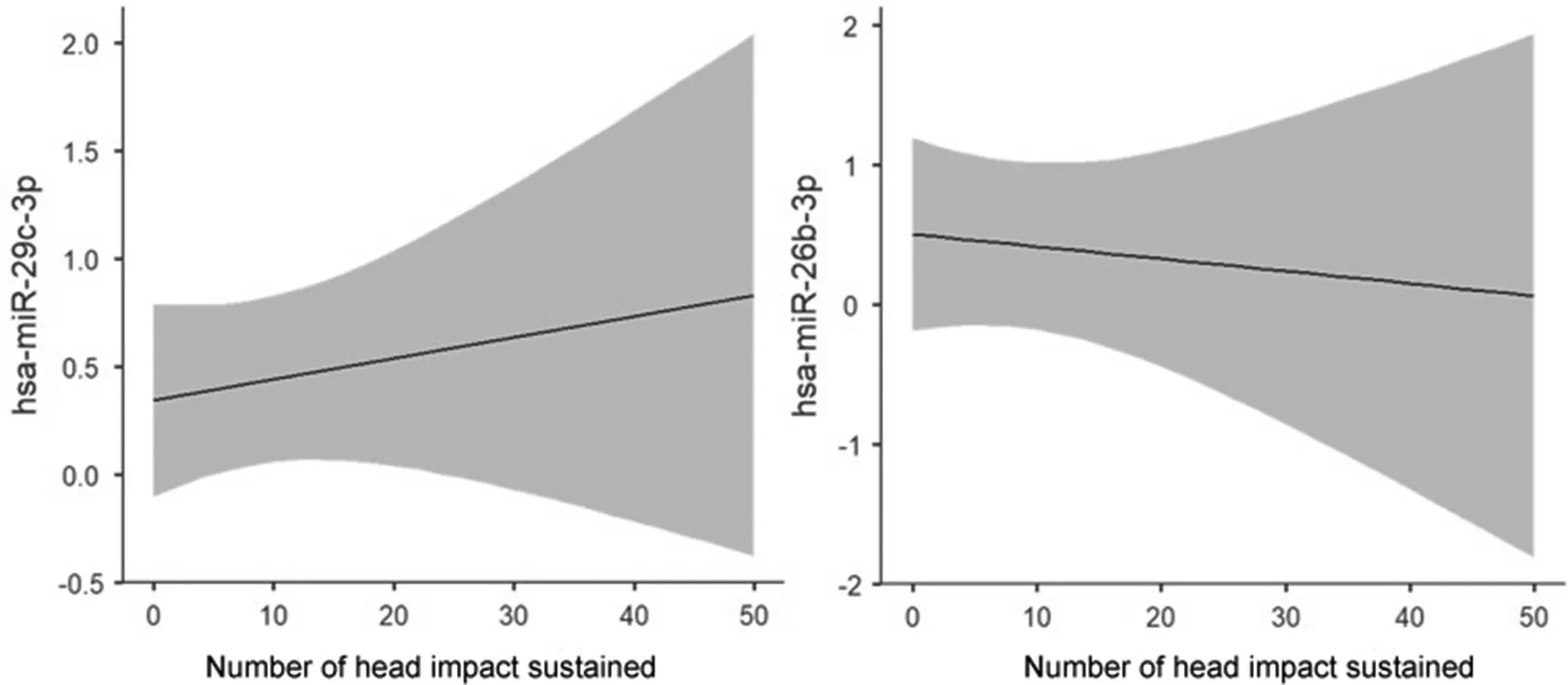
Fig.3.Levels of 2 miRNAs are related to the number of head impacts sustained.Marginalized means plots display the relationship between the number of head impacts sustained in a single football practice and the pre-/post-practice change in normalized saliva miRNA concentration.A greater number of head impacts sustained in a single practice was associated with an increase in post-practice levels of miR-29c-3p relative to pre-practice baseline levels(R=0.59,p=0.006);a greater number of head impacts was also associated with a reduction in post-practice levels of miR-26b-3p relative to pre-practice baseline(R=-0.51,p=0.020).The shaded area represents the 95%confidence interval.hsa=Homo sapien;miRNA=micro ribonucleic acid.TagedEnd
3.4. Diagnostic ability of SRC-related miRNAs
The 15/40 salivary miRNAs unaffected by acute exercise or season-long exercise were interrogated as diagnostic candidates for SRC.Ability of individual miRNAs to differentiate concussed and non-concussed participants was quantified by AUC on a logistic regression analysis (Table 2).The majority of these candidates (11/15) demonstrated a significant difference (adjustedp< 0.05) between concussed and non-concussed participants,and 6 miRNAs displayed moderate differential ability (AUC ≥0.70).The most accurate miRNA for differentiating concussed and non-concussed participants was miR-27a-5p (AUC=0.78,sensitivity=74%,specificity=75%).A logistic regression model employing a ratio of miR-27a-5p and miR-30a-3p(logit(P)=0.155+0.169 miR-27a-5p/miR-30a-3p) achieved the highest accuracy (AUC=0.810,sensitivity=82.4%,specificity=73.3%) for differentiating concussion status (Fig.4).Adding age and sex as covariates to this model did not appreciably change predictive accuracy (AUC=0.811,95% confidence interval (95%CI): 0.734-0.880).There was no difference(z=1.69,p=0.09) in the proportion of misclassified individuals with recent exercise (29/88,33%)vs.those without recent exercise (18/84,21%).Similarly,there was no difference (z=0.5,p=0.60)in the proportion of misclassified individuals with SRC(10/42,24%),vs.those with non-SRC(6/33,18%).
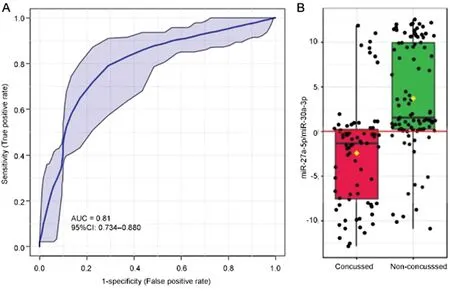
Fig.4.A single miRNA ratio differentiates concussed and non-concussed individuals.(A)A receiver operator characteristic curve displays the relative sensitivity and specificity of a logistic regression algorithm employing concentrations of miR-27a-5p and miR-30a-3p for differentiating 75 concussed individuals from 97 non-concussed individuals.The ratio achieved an AUC of 0.81(95%CI:0.734-0.880),with 82.4%sensitivity and 73.3%specificity;(B)Levels of miR-27a-5p/miR-30a-3p were lower among concussed individuals.Notably,both miRNAs displayed no effect of acute or chronic exercise,and they differentiated SRCs and non-SRCs with similar accuracy.95%CI=95%confidence interval;AUC=area under the curve;miRNA=micro ribonucleic acid;SRCs=sport-related concussions.TagedEnd

Table 2 Diagnostic accuracy of 15 salivary miRNAs unaffected by acute exercise or season-long exercise.
4.Discussion
This study identified saliva miRNAs that could potentially identify SRC without confounding effects of acute exercise or season-long training.A single miRNA ratio(measurable in 1 tube using dual-channel quantitative polymerase chain reaction)identified concussion status with an AUC of 0.810.This accuracy is similar to that of serum biomarkers.33-36,18,37-40For any biological marker of SRC,it is critical to determine the impact of acute or chronic exercise.41-43The present study defines this important relationship for saliva miRNAs.
4.1. Clinical implications
Clinicians performing sideline assessments of athletes rely primarily on subjective symptom reports,balance measures,and neurocognitive testing to identify SRC.2,44These tools perform optimally when baseline assessments are available.45Despite their diagnostic utility,they can be manipulated by athletes wishing to avoid removal from play.3,46Neurocognitive testing must be administered by a trained professional,47and the time required for test administration often prohibits sideline administration.48Development of an objective saliva miRNA assessment for concussion could address several of these limitations.Perhaps the biggest value of salivary miRNA is rapid obtainment with minimal medical training.Previous studies have demonstrated that miR-27a and miR-30a levels may hold diagnostic utility for concussion when measured in blood or saliva.9-11,14,49However,serum markers involve a blood draw,which requires an invasive medical procedure with potential for infection.Measurement of sensitive and specific salivary miRNAs in real time could lead to a rapid sideline test,easily deployed by athletic trainers.Such a test could prove particularly useful when assessing athletes with transient symptoms who pass sideline testing,but where suspicion of underlying head injury persists.Although miR-27a and miR-30a are found in tissues throughout the human body,50,51both miRNAs are expressed by peripheral nerves (such as those innervating the pharynx),where they have been shown to control pathophysiologic processes relevant to concussion,such as pain modulation and cerebral ischemia-reperfusion injury.52,53
4.2. Biological implications
The biological relevance of miR-27a and miR-30a to SRC pathophysiology underscores the unique role that these biomarkers may serve in SRC.Existing SRC assessments characterize subjective symptoms and functional changes that arise from brain injury.However,these measures do not detect the brain injury itself.54Reliance on such assessments may contribute to under-recognition of brain injury.55-57It may also hinder advances in SRC treatment,which currently focuses on addressing symptomatic manifestations,rather than underlying biological changes.Finally,reliance on symptomatic and functional changes diminishes the importance of minor head impacts that may accumulate to raise an athlete’s SRC risk.58,59Since it will be nearly impossible for diagnostic biomarkers to outperform a subjective gold standard of SRC,integration of biomarkers into SRC evaluation and treatment will likely require a major paradigm shift.For example,in the present study,2 molecules implicated in concussion pathophysiology (miR-26b-3p and miR-29c-3p) were found to change at the end of a contact sports season and to correlate with the burden of non-concussive head impacts.Validation of this relationship in a larger,longitudinal cohort of contact sport athletes with sensitive measures of head impact burden could eventually be used to create a biological test for nonconcussive head impacts that raise SRC risk.
4.3. Strengths and limitations
The enrollment of athletes from a wide variety of sports,across 10 different clinical sites,enhances the generalizability of these findings.To our knowledge,this is the largest study of miRNA changes with exercise,60and the first to examine saliva miRNA changes with both acute exercise and cumulative(season-long)sports participation.We note that the timing between exercise and saliva collection varied among participants.Participants with SRC were enrolled within 24 h of injury(and exercise)because previous research has shown that exercise can impact miRNA levels for up to 24 h.61However,exercise controls were enrolled within 2 h of exercise.This difference in “recent exercise” definition may have impacted misclassification rates for the predictive miRNA ratio.However,we expect that such a difference would lead to overestimation of misclassification rates,which did not differ between individuals with/without recent exercise.In addition,few miRNAs (2/40)displayed an acute effect of exercise,and these miRNAs were excluded from diagnostic consideration.
Our study design does not allow us to definitively determine whether the saliva miRNAs that change with season-long participation in contact sports are impacted by cumulative fatigue,musculoskeletal injuries,or conditioning.Our exploratory analysis suggested that 2 saliva miRNAs that changed during a contact sports season (miR-26b-3p and miR-29c-3p)were also associated with the number of head impacts in a single practice.However,larger studies utilizing more sensitive,objective measures of head impacts over a full season of contact sport are needed to confirm this finding.Use of accelerometers or video recordings may provide more accurate estimates of head impacts than the direct observation used in this study.Our analysis of season-long changes in salivary miRNAs excluded participants who suffered a concussion during the course of the season as well as participants who had orthopedic injuries at the time of saliva collection,but no data are available for intra-season injuries.Finally,the study was not powered to examine sport-specific effects on saliva miRNA levels because our goal was to identify saliva miRNAs that display consistent changes across a wide variety of sports,which may limit their utility as sideline biomarkers for SRC.
5.Conclusion
This study contributes to growing evidence regarding salivary miRNAs as potential concussion biomarkers.We identify a subset of salivary miRNAs that are impacted by acute exercise or season-long participation in contact sports.Such miRNAs may constitute poor biomarkers for SRC because they could confound sideline measurements or comparisons with pre-season baselines.The salivary miRNAs unaffected by exercise represent promising biomarker candidates for SRC.Indeed,a ratio of 2 of these miRNAs (miR-27a-5p and miR-30a-3p) differentiated individuals with concussion regardless of exercise status and displayed similar accuracy to serum biomarkers.Future investigations prospectively validating the response of these miRNAs in large populations of athletes would provide additional evidence for their clinical utility in SRC.
Acknowledgments
The authors thank Alexandra Confair,Molly Carney,Jessica Beiler,Katsiah Cadet,Elizabeth Packard,Jennifer Stokes (Penn State University),Kyle Kelleran (Bridgewater College),Allison Iles,Arianna Montefusco,Rhianna Ericson,Kayla Wagner (Quadrant Biosciences),Matthew Badia,and Jason Randall (Marist College) for aiding with participant enrollment and sample analysis.We thank Eric Schaefer and Vonn Walter(Penn State)for guidance on statistical modeling,Frank Middleton (SUNY Upstate) and Aakanksha Rangnekar(Quadrant Biosciences) for assistance with RNA processing and alignment,and Kevin Heffernan(Syracuse University)for article appraisal and revisions.
This project was supported by a sponsored research agreement between Quadrant Biosciences and the Penn State College of Medicine to ACL.SDH’s time was supported by the National Center for Advancing Translational Sciences(Grant KL2 TR002015 and Grant UL1 TR002014).The content is solely the responsibility of the authors and does not necessarily represent the official views of the funding sources.Material has been reviewed by the Walter Reed Army Institute of Research.There is no objection to its presentation and/or publication.The opinions or assertions contained herein are the private views of the author and are not to be construed as official or as reflecting true views of the Department of the Army or the Department of Defense.The investigators have adhered to the policies for protection of human subjects as prescribed in AR 70-25.
Authors’contributions
SDH designed the study,oversaw sample collection,analyzed the data,and drafted and revised the manuscript;ACL and SLZ contributed to the study design;RYK,KJZ,JL,RPO,CaM,MMM,TL,MH,ChM,EF,MND,and TRC were involved in sample acquisition;GF and SDV oversaw sample processing;ZG,GF,and CN contributed to data analysis;CO,SLZ,and MND participated in the drafting of the article.All authors have read and approved the final version of the manuscript,and agree with the order of presentation of the authors.
Competing interests
SDH is a paid consultant and scientific advisory board member for Quadrant Biosciences.He is named as a coinventor on intellectual property related to saliva RNA biomarkers in concussion that is patented by The Penn State College of Medicine and licensed to Quadrant Biosciences.SDV and GF are paid employees of Quadrant Biosciences.CN has equity interest in Quadrant Bioscience Inc.All the support had no involvement in the study design and writing of the manuscript or the decision to submit it for publication.The other authors declare that they have no competing interests.
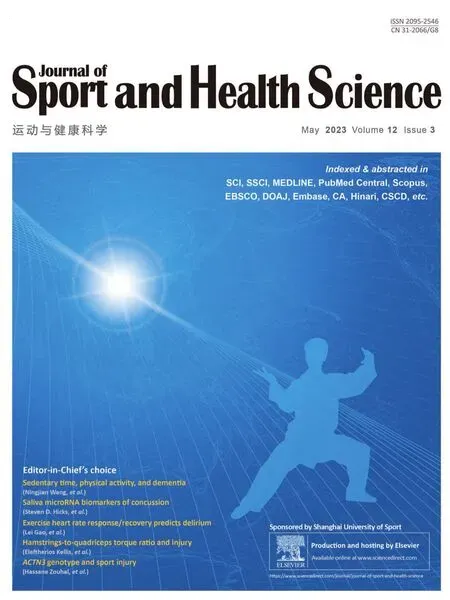 Journal of Sport and Health Science2023年3期
Journal of Sport and Health Science2023年3期
- Journal of Sport and Health Science的其它文章
- Impact loading in female runners with single and multiple bone stress injuries during fresh and exerted conditions
- Are EPB41 and alpha-synuclein diagnostic biomarkers of sport-related concussion?Findings from the NCAA and Department of Defense CARE Consortium
- Factors and expectations influencing concussion disclosure within NCAA Division I athletes:A mixed methodological approach
- Effects of contact/collision sport history on gait in early-to mid-adulthood
- Association between ACTN3 R577X genotype and risk of non-contact injury in trained athletes:A systematic review
- Lacrosse-related injuries in boys and girls treated in U.S.emergency departments,2000-2016
